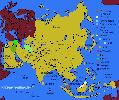|
|
|
|
|
|
|
|
|
|
|
|
|
|
| | |
|
|
|
|
| | |
| Name | latin |
Theopropus elegans |
| | |
|
| Systematics
Systematics
|
|
All data for the systematics is taken from Reinhard Ehrmann's book "Mantodea - Gottesanbeterinnen der Welt" (Mantodea - Praying mantids of the world).
More about this book can be found in the section literature at this page.
|

|

| Super-Order |
Dictyoptera |
| Order |
Mantodea |
| Family |
Hymenopodidae |
| Subfamily |
Hymenopodinae |
| Tribe |
Hymenopodini |
| |
|
| | First Description | Author |
WESTWOOD |
| Year |
1832 |
| |
|
| Size
Quotation of Size
|
|
The given size is measured from the head to the end of the abdomen, without the wings.
|

|

| Male |
ca. 1,5cm |
| Female |
ca. 3,5cm |
| |
|
| Lifespan
Quotation of the Lifespan
|
|
The lifespan is given in month and has the following definition:
overall-age ("time between hatching and imago" + "lifespan after the last molting")
Example: 9 (2 + 7) month lifespan
overall-age = 9 month
time between hatching and imago = 2 month
lifespan after the last molting = 7 month
|

|

| Male |
ca. 5 (2 + 3) months / ~ 5 moltings |
| Female |
ca. 10 (4 + 6) months / ~ 7 moltings |
| |
|
| Sexing
Sexing
|
|
Morphologically differences between male and female.
|

|

| Male |
L4 and above: appendages at the abdomen visible (females not till l6), the antenna`s base is thickened
adult: essentually smaller than females, very thin and delicate, very good flyers, with a buzzing noise when flying |
| Female |
L4 and above: no appendages at the abdomen visible, bigger than males at the same state
L6 and above: small appendages at the abdomen visible, which grow with every molting, bigger than males at the same state
adult: essentually bigger and more compact than males |
| |
|
| | | | Spreading
Spreading
|
|
For a better overview, only whole countries are listed for the quotation of spreading, even if a species can only be found in a small part of that country.
All data for the spreading is taken from Reinhard Ehrmann's book "Mantodea - Gottesanbeterinnen der Welt" (Mantodea - Praying mantids of the world).
More about this book can be found in the section literature at this page.
At the menu "Spreading" for each country only the genus but the species is printed (Exception: on this site described species).
|

|

| Borneo, Malaysian Peninsula, Myanmar, Java, Sumatra |
| |
| |
| |
|
| |
 |
| Asia |
|
| | Habitat | branched leafage
inhabits damp areas (rainforest) |
| |
|
| | Aggressiveness | high (females) |
| |
|
| | Colorvariants | none, subwings of the females can differ from yellow to red |
| |
|
| | Hint | huge size- discrepancy between the sexes
In case of danger, the females drop down and remain motionless. The flight occurs with fast, short jumps. |
| |
|
|
| |
|
|
|
|
|
|
|
|
|

